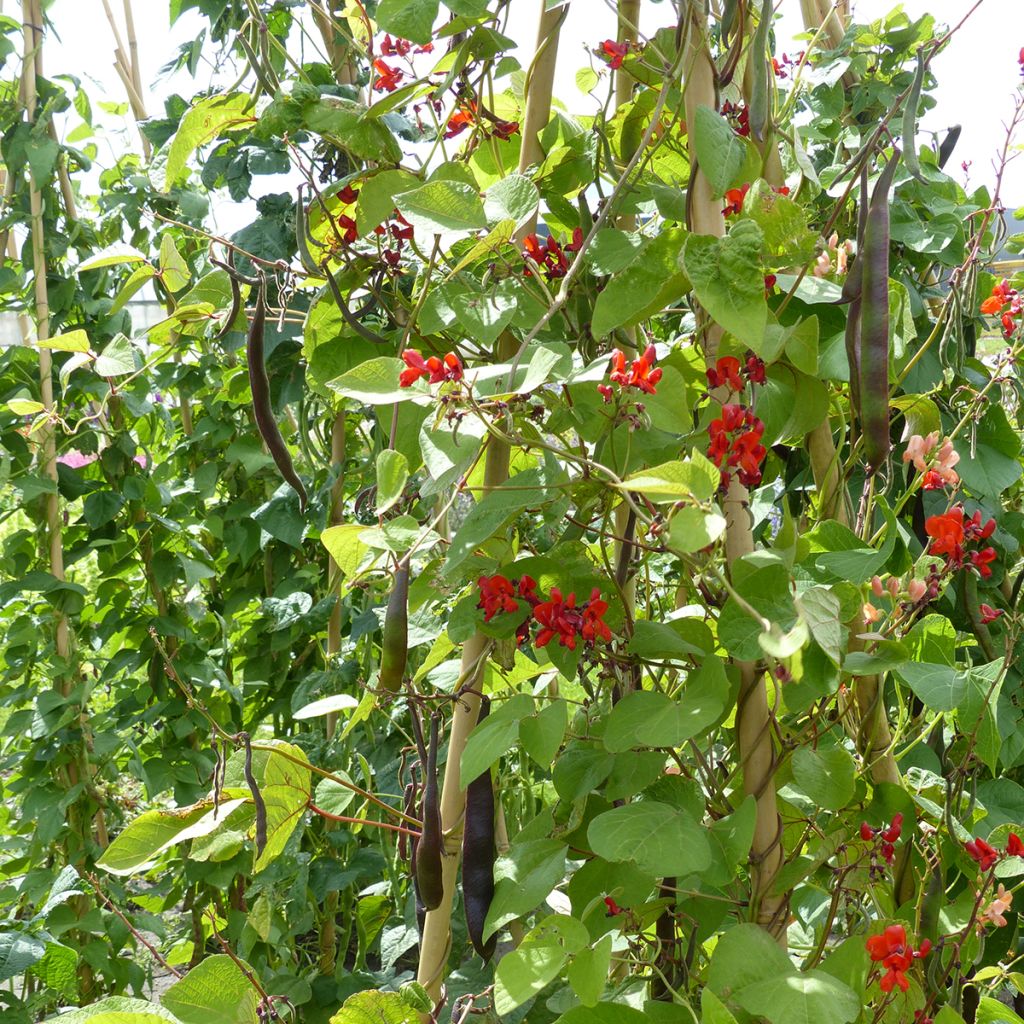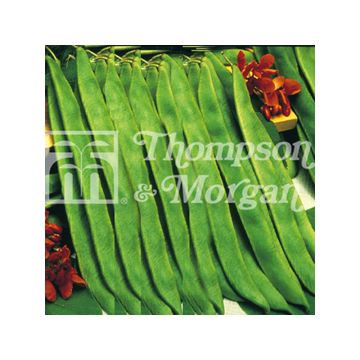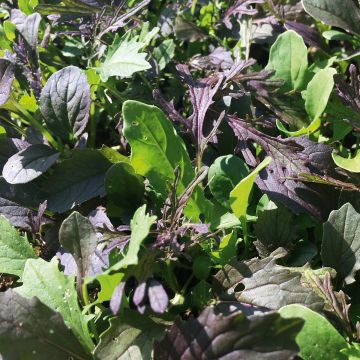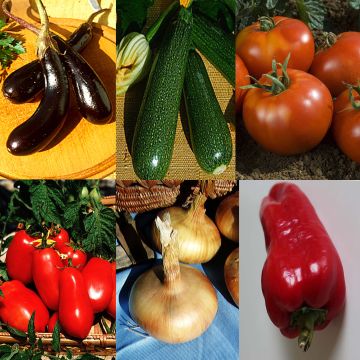

Runner Bean Black Knight seeds
Runner Bean Black Knight seeds
Phaseolus coccineus Black Knight
Runner Bean, Scarlet Runner Bean
This item cannot be shipped to the selected country
Dispatch by letter from €3.90
More information
Schedule delivery date,
and select date in basket
This plant carries a 6 months recovery warranty
More information
We guarantee the quality of our plants for a full growing cycle, and will replace at our expense any plant that fails to recover under normal climatic and planting conditions.
Seed-only orders are dispatched by sealed envelope. The delivery charge for seed-only orders is €3.90.
Description
The 'Black Knight' runner bean is an old English variety obtained in the 1800s by Edmund Knight, Bishop of Shrewsbury. The climbing plant produces beautiful and large orange-red flowers. They are characteristic of the runner bean (Phaseolus coccineus) which is also known as Scarlet Bean or Flower Bean for this reason. The flowers give way to numerous pods that can be consumed young and tender as snap beans. They then have a green bean flavour. The pods mature and become almost black and parchment-like, making them unfit for consumption. However, the seeds inside the pods are delicious fresh or dried. In this 'Black Knight' variety, they change from bright pink when fresh to dark brown speckled when dry.
Combine usefulness and beauty by inviting this beautiful runner bean 'Black Knight' into your vegetable garden, or your ornamental garden. Plan to sow from April to June to harvest from July to September. Each plant quickly reaches 2m (7ft) high, clinging to the support provided. Place several seeds in a hole at the base of each support. The seeds need to be buried at least 5cm (2in) deep in the soil to germinate. Even the cotyledon germinates underground before the first true leaves appear.
Whether consumed for its pod or its seed, the bean is a highly appreciated vegetable in gardens because it is very easy to grow. It is so reliable that gardeners know the exact date when they will have their first harvest, 60 days after sowing.
Discovered in the New World and acclimatised in Europe from the 16th century onwards, the bean has now become an essential legume in all world cuisines. Native Americans cultivated it for its dried seeds, but it was the Italians who first ate the whole, immature pod in the 18th century.
The bean is a climbing plant with indeterminate growth. Primitive varieties are all climbing and require support. Later, for practical reasons, dwarf varieties were selected, but all have tendrils that can wrap around a support. The runner bean, Phaseolus coccineus, is a perennial herbaceous plant with a tuberous taproot, not hardy, and grown as an annual. It is a legume species (Fabaceae family) native to the mountains of Central America and Mexico.
Harvest: Harvesting fresh seeds or young pods begins approximately 60 days after sowing. For fresh seeds, it should be done before the pods start to dehydrate and develop wrinkles. The seeds should barely take on their colour. For pod consumption, harvest every 2 or 3 days. Harvesting dried seeds involves cutting the entire plant, which should then be hung in a dry and airy place. The seeds can be shelled as needed.
Storage: Freezing pods is now the most common method of preservation. To do this, remove the stems, wash the pods, blanch them for 5 to 6 minutes in boiling water, then plunge them into cold water and dry them with a clean cloth. Once placed in a bag, the beans can be placed in the freezer at -18°C (-0.4°F). However, canning is regaining its popularity among an increasing number of consumers due to the inherent taste qualities of this preservation method. As with freezing, remove the stems, wash and blanch the beans, then place them in jars filled with boiling salted water. Close the jars and sterilise them in a pressure cooker or with a steriliser for 1 hour and 30 minutes over medium heat. To do this, completely cover the jars with water after securing them well.
Dried beans: When completely dry, bean seeds can be stored for up to a year if kept under good conditions, such as in airtight jars.
Gardener's tip:
Beans, like all members of the Fabaceae family, can fix nitrogen from the air into the soil through a plant-bacteria symbiosis. They can regenerate soils. Beans can be included in crop rotation after green manure. Traditionally, bean cultivation in Central and South America is associated with the cultivation of squash and corn, forming a beneficial triad. This association is called three sisters. Beans also pair well with aubergines, carrots, cabbages, potatoes, and radishes, as they protect each other. Avoid growing with alliums or fennels, as their growth is inhibited.
Spraying with nettle manure effectively combats aphid attacks and strengthens the plants.
Report an error about the product description
Harvest
Plant habit
Foliage
Botanical data
Phaseolus
coccineus
Black Knight
Fabaceae
Runner Bean, Scarlet Runner Bean
Cultivar or hybrid
Annual
Other Runner beans
Planting and care
Soil preparation: The Spanish Bean likes light, moist but not waterlogged, nutrient-rich soils. However, it does not like soils that are too chalky or too acidic. Therefore, it is important to prepare the soil by deep digging to a depth of 20 cm (8in) without turning the soil. Then, it should be amended with compost or well-decomposed manure. Do not sow the bean on soil that has been recently limed, as this causes hardening and reduces the taste quality of the pod.
Sowing under cover: Under cover or in tunnels, bean sowing can begin as early as mid-March. Beans are sensitive to cold and require a minimum soil temperature of 15°C (59°F). The covers should be oriented to the south or west. Only open them during the warmest hours of the day. Remove the covers only when there is no longer a risk of frost.
Sowing in open ground: Sowing should be done from April or May when the soil has warmed up enough and there is no longer a risk of frost. Dig furrows 3 to 4 cm (1 to 2in) deep, spacing them 40 cm (16in) apart. Sow your seeds 5 to 7 cm (2 to 3in) apart or in groups of 4 to 5 seeds, spacing them 40 cm (16in) apart in all directions. Cover the soil and lightly press it down with a rake. When the plants reach a height of 20 cm (8in), mound up the soil around the base to provide support.
The first harvests can be made about 60 days after sowing, and continue until October. You can sow beans every 15 days for a continuous harvest until the end of autumn.
There are different types of support for climbing beans: the Canadian tent, tipi, nets or grids. Any tall element can be used as support for this type of bean, which makes it more attractive.
Seedlings
Care
Intended location
This item has not been reviewed yet - be the first to leave a review about it.
Vegetable seeds
Haven't found what you were looking for?
Hardiness is the lowest winter temperature a plant can endure without suffering serious damage or even dying. However, hardiness is affected by location (a sheltered area, such as a patio), protection (winter cover) and soil type (hardiness is improved by well-drained soil).

Photo Sharing Terms & Conditions
In order to encourage gardeners to interact and share their experiences, Promesse de fleurs offers various media enabling content to be uploaded onto its Site - in particular via the ‘Photo sharing’ module.
The User agrees to refrain from:
- Posting any content that is illegal, prejudicial, insulting, racist, inciteful to hatred, revisionist, contrary to public decency, that infringes on privacy or on the privacy rights of third parties, in particular the publicity rights of persons and goods, intellectual property rights, or the right to privacy.
- Submitting content on behalf of a third party;
- Impersonate the identity of a third party and/or publish any personal information about a third party;
In general, the User undertakes to refrain from any unethical behaviour.
All Content (in particular text, comments, files, images, photos, videos, creative works, etc.), which may be subject to property or intellectual property rights, image or other private rights, shall remain the property of the User, subject to the limited rights granted by the terms of the licence granted by Promesse de fleurs as stated below. Users are at liberty to publish or not to publish such Content on the Site, notably via the ‘Photo Sharing’ facility, and accept that this Content shall be made public and freely accessible, notably on the Internet.
Users further acknowledge, undertake to have ,and guarantee that they hold all necessary rights and permissions to publish such material on the Site, in particular with regard to the legislation in force pertaining to any privacy, property, intellectual property, image, or contractual rights, or rights of any other nature. By publishing such Content on the Site, Users acknowledge accepting full liability as publishers of the Content within the meaning of the law, and grant Promesse de fleurs, free of charge, an inclusive, worldwide licence for the said Content for the entire duration of its publication, including all reproduction, representation, up/downloading, displaying, performing, transmission, and storage rights.
Users also grant permission for their name to be linked to the Content and accept that this link may not always be made available.
By engaging in posting material, Users consent to their Content becoming automatically accessible on the Internet, in particular on other sites and/or blogs and/or web pages of the Promesse de fleurs site, including in particular social pages and the Promesse de fleurs catalogue.
Users may secure the removal of entrusted content free of charge by issuing a simple request via our contact form.
The flowering period indicated on our website applies to countries and regions located in USDA zone 8 (France, the United Kingdom, Ireland, the Netherlands, etc.)
It will vary according to where you live:
- In zones 9 to 10 (Italy, Spain, Greece, etc.), flowering will occur about 2 to 4 weeks earlier.
- In zones 6 to 7 (Germany, Poland, Slovenia, and lower mountainous regions), flowering will be delayed by 2 to 3 weeks.
- In zone 5 (Central Europe, Scandinavia), blooming will be delayed by 3 to 5 weeks.
In temperate climates, pruning of spring-flowering shrubs (forsythia, spireas, etc.) should be done just after flowering.
Pruning of summer-flowering shrubs (Indian Lilac, Perovskia, etc.) can be done in winter or spring.
In cold regions as well as with frost-sensitive plants, avoid pruning too early when severe frosts may still occur.
The planting period indicated on our website applies to countries and regions located in USDA zone 8 (France, United Kingdom, Ireland, Netherlands).
It will vary according to where you live:
- In Mediterranean zones (Marseille, Madrid, Milan, etc.), autumn and winter are the best planting periods.
- In continental zones (Strasbourg, Munich, Vienna, etc.), delay planting by 2 to 3 weeks in spring and bring it forward by 2 to 4 weeks in autumn.
- In mountainous regions (the Alps, Pyrenees, Carpathians, etc.), it is best to plant in late spring (May-June) or late summer (August-September).
The harvesting period indicated on our website applies to countries and regions in USDA zone 8 (France, England, Ireland, the Netherlands).
In colder areas (Scandinavia, Poland, Austria...) fruit and vegetable harvests are likely to be delayed by 3-4 weeks.
In warmer areas (Italy, Spain, Greece, etc.), harvesting will probably take place earlier, depending on weather conditions.
The sowing periods indicated on our website apply to countries and regions within USDA Zone 8 (France, UK, Ireland, Netherlands).
In colder areas (Scandinavia, Poland, Austria...), delay any outdoor sowing by 3-4 weeks, or sow under glass.
In warmer climes (Italy, Spain, Greece, etc.), bring outdoor sowing forward by a few weeks.




















































